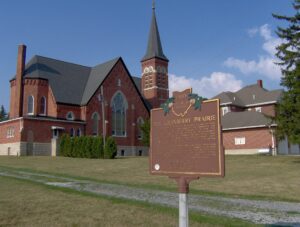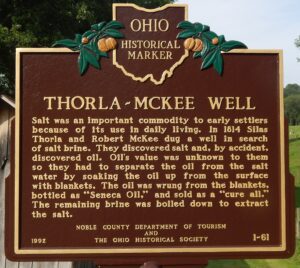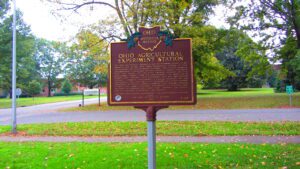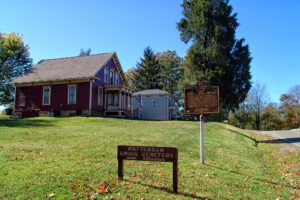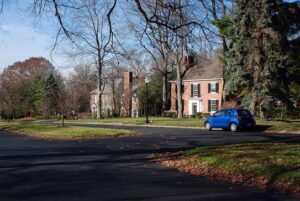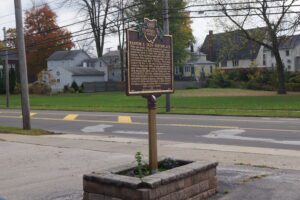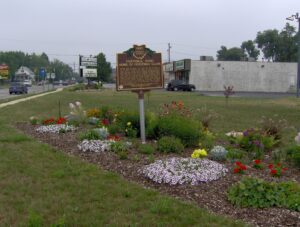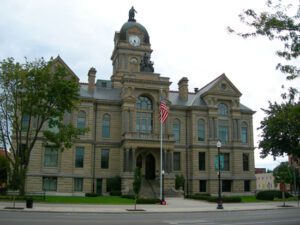, OH
The Cranberry Prairie, southwest of this marker, is a part of Ohio’s natural history. The place was named for the cranberries that grew in a swamp here prior to drainage of the area. The Cranberry Prairie was created by centuries of peat accumulation in a late Ice Age lake that formed at the base of St. John’s Moraine. Paleo-Indian or Early Archaic peoples probably killed the elk whose skeleton was dug up here in 1981. This elk was dated at approximately 7400 B.C. By the 1860s, immigrant German farmers had begun transforming the swamp into fertile farmland. “Wild Bill” Simison, a legendary inhabitant, lived in the swamp and settlers respected him for his knowledge of the area. By the turn of the nineteenth century, Granville Township School #7, St. Francis Catholic Church, and Bertke’s Store stood at the edge of the Cranberry Prairie.
, OH
Salt was an important commodity to early settlers because of its use in daily living. In 1814 Silas Thorla and Robert McKee dug a well in search of salt brine. They discovered salt and, by accident, discovered oil. Oil’s value was known to them so they had to separate the oil from the salt water by soaking the oil up from the surface with blankets. The oil was wrung from the blankets, bottled as “Seneca Oil,” and sold as a “cure all.” The remaining brine was boiled down to extract the salt.
, OH
The Ohio General Assembly established the Ohio Agricultural Experiment Station in 1882. From its inception until 1892, the Station occupied 17 acres on the Columbus campus of The Ohio State University before relocating to 470 acres in Wayne County. In 1965, the Station changed its name to the Ohio Agricultural Research and Development Center (OARDC) to more accurately reflect its mission and programs. In 1982, the Center formally merged with The Ohio State University. Today, the Center encompasses nearly 2,100 acres in Wayne County with 10 branches located across the state for a total of approximately 7,100 acres dedicated to agricultural research.
, OH
Mary Leonore Jobe was born on January 29, 1878, near Tappan, Harrison County, Ohio. She earned a bachelor’s degree from Scio College and master’s degree from Columbia University. While studying, she began a life-long career of exploration and natural history investigation. She first explored areas of British Columbia, Canada in 1905 and in 1916 started Camp Mystic, a summer camp in Connecticut for girls. She married explorer Carl E. Akeley in 1924 and completed an expedition to Africa when Carl died in the Belgian Congo in 1926. Honors include the naming of Mount Jobe in Canada to recognize her achievements and Belgium awarding her the Cross of the Knight, Order of the Crown, for her work in the Belgian Congo. She is known for her books and contributions to the American Museum of Natural History in New York. She died on July 19, 1966, and is buried in Deersville.
, OH
Youngstown’s earliest automobile suburb, Forest Glen Estates was developed in the 1920s during a period of change in urban transportation patterns and rapid expansion in the regional steel economy. A composite of design work by leading northeastern Ohio landscape and residential architects, the park-like suburb integrates period revival architecture into the natural landscape and blends gracefully with adjacent Mill Creek Park. Gently curving streets with low curbs and landscaped islands were a novel departure from traditional grid patterns. Attached garages and walkways that connect to driveways rather than the street reflect the influence of the personal automobile in the suburban landscape during this era. In 1998, the Forest Glen Estates Historic District was listed on the National Register of Historic Places.
, OH
Ransom E. Olds was born on this property on June 3, 1864. Olds co-founded the Olds Motor Vehicle Company, forerunner of the Oldsmobile Division of General Motors in Lansing, Michigan, on August 21, 1897. The curved dash model, built from 1900 to 1907, was the first car to carry the name Oldsmobile. With a 66-inch wheelbase, it weighed about 650 pounds, cost $650, and was powered by a one-cylinder, seven-horsepower engine capable of a speed of 20 miles per hour. It was the first commercially successful American-made automobile built using a progressive assemble system that led to modern mass-production methods.
, OH
Fostoria’s glass era began when natural gas was discovered in the mid 1880s at “Godsend,” five miles west of town. Aided by former governor Charles Foster, Fostoria attracted more than a dozen companies that manufactured utilitarian and decorative glassware from 1887 to 1920. These companies produced windows, bottles, tableware, lamps, shades, and electric incandescent lamps. The Fostoria Glass Company was the best-known manufacturer of glass in Fostoria. From 1887 to 1891, it made a wide variety of decorative glass including its famous “Victoria” pattern tableware. Even after the company relocated to Moundsville, West Virginia following the depletion of natural gas in the area, it retained the name “Fostoria, ” which is still synonymous with excellence in the glass-making art.
, OH
Hancock County was organized March, 1828, court being held in a log schoolhouse. In 1833, a frame courthouse was built. It served until 1840, when a brick structure went up on this site. During the oil and gas boom of the 1880’s, the present courthouse was erected at a cost of $305,272, and dedicated Oct. 27, 1888.


